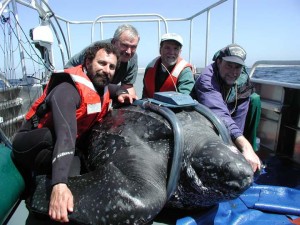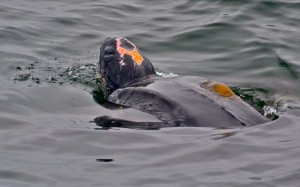Go sailing off the coast in late summer and you might not notice a Pacific leatherback turtle when one swims past you, even though it is the largest turtle in the world—it can grow up to 1,500 pounds. A solitary creature, it glides smoothly through the water, its mottled blue-gray back blending in with its surroundings and obscuring its huge bulk. From beneath, it is covered with white spots, which help it blend in against the sun-dappled ocean surface.
The Bay Area coastline is at the end of a 7,000-mile journey for the Pacific leatherback. It has been migrating along the same oceanic routes since the time of the dinosaurs. Most years, it starts in Indonesia in April and travels across the Pacific Ocean until it reaches the California coast between Monterey and Bodega Bay in late summer and stays into fall. It is searching for one thing: jellyfish.
The leatherbacks arrive when the waters off the coast are the warmest and when sea life here is thriving following the summer upwelling that brings nutrients up from the ocean floor. Although the Pacific leatherback will eat salps and other gelatinous organisms, its favorite food in California seems to be the brown sea nettle, a large jellyfish with vein-like tentacles that it uses to paralyze its prey. The leatherback is uniquely adapted to eating jellyfish. Not only is it unaffected by the sting of the nettle’s nematocysts, its esophagus is lined with coarse brushes called papillae that point toward its stomach to keep the jellyfish from coming back out of its mouth.
The Pacific leatherback is often said to be the size of a car, but that’s an exaggeration. Still, a full-grown turtle can measure 6 feet long, 3 feet tall, and 4 feet wide. Yet, when the turtle first hatches on an Indonesian beach, it’s only a little bigger than a silver dollar. As the tiny reptile emerges from its egg and travels down the beach to the water, it faces the most dangerous period of its life—many predators, from birds to mammals to fish, want to eat it. This may be why the female turtle lays so many eggs to begin with. Every 10 days, she comes up on the beach, digs a hole, and lays a clutch of 80 to 100 eggs. She repeats this until she has laid roughly 1,000 eggs. Of those, maybe two turtles might make it to the sea, and even then, they may fall prey to other sea life. Given this bumpy start, its no wonder that the males never go on land again in their lifetimes, and that the females only return to lay eggs. Home to the Pacific leatherback is the ocean.
The leatherback has been around for 70 million years and is the last surviving member of its family. Unlike other turtles, which have external plates or scales (called scutes) that form a hard shell, the leatherback has bony ridges that fit together along its back like a jigsaw puzzle. These, in turn, are covered with a leather-like skin that that will bleed if you scratch it. Its pliable shell can bend under pressure, which is why the Pacific leatherback can dive over 3,000 feet, deeper than any other turtle.
While much about the leatherback remains a mystery, scientists speculate that a full-grown Pacific leatherback has few predators. Despite this, its population has decreased by an estimated 90 percent in the last 25 years. The reason for its decline is multifaceted, starting at beaches in Indonesia where the turtles are born. Locals have eaten turtle eggs for centuries, but lately poachers have begun harvesting them to sell in markets. On top of that, Pacific leatherbacks are often accidentally caught by long-line fishing boats, whose 75-mile lines have thousands of sharp hooks meant to catch swordfish and tuna. Leatherbacks also choke on plastic trash in the ocean, which they mistake for jellyfish.
But while the Pacific leatherback’s future may be in peril, it’s still possible to spot these ancient giants within swimming distance from land. Just go out in September when the water is warmest. All you have to do is follow the jellyfish.
For more about sea turtle conservation and efforts to limit long-line fishing, go to the Sea Turtle Restoration Project’s web site at www.seaturtle.org or email Michael@seaturtle.org.

.jpg)


-300x221.jpg)
-300x221.jpg)